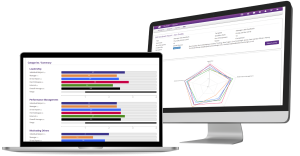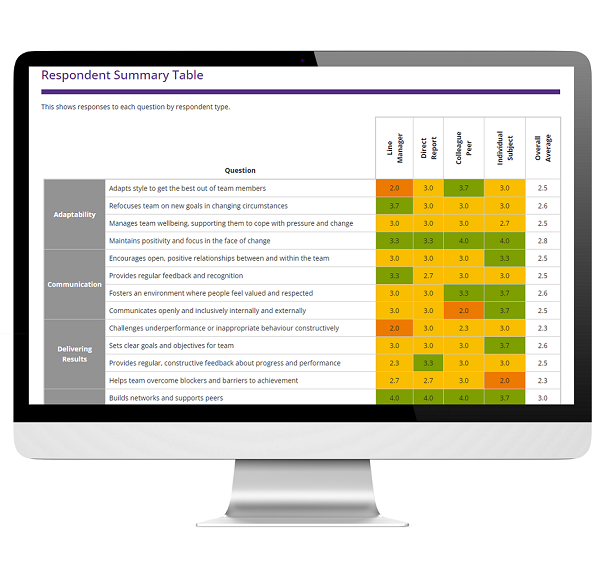Get in touch with us today!
If you have any questions, enquiries or just want to say how much you like us (or what we can do better), please drop us a line.

360 Degree Feedback is a comprehensive employee performance evaluation method that gathers input from multiple sources including external stakeholders or clients if relevant, gaining their perspective surrounding an individual. It entails gathering employee feedback from various sources, including superiors, direct reports, subordinates, peers, and sometimes external stakeholders.
The information captured from the feedback providers gives a holistic assessment of an individual’s skills, behaviours, and the employee performance. The 360 Feedback process approach aims to offer a well-rounded view of the individual’s strengths, areas for improvement, and professional development opportunities, highlighting the benefits of receiving diverse feedback . The feedback typically covers a range of critical competencies, behaviours, and values relevant to the individual’s role and responsibilities. The 360 Feedback process, when well managed encourages self-awareness, promotes professional growth, personal development and fosters transparent communication within organisations.
However, 360 Feedback and performance reviews are different, although they can complement each other. A summary of the key differences include:
Feedback scope, Typically a performance appraisal involves a manager evaluating an employee’s performance against pre-set goals and objectives. It often includes regular check-ins, goal setting, and a regular performance review.
The purpose, 360 Degree Feedback is primarily used for personal and professional development. It helps individuals understand their strengths and areas for improvement from various perspectives.
Performance Management however focuses on evaluating and improving employee performance to meet organisational goals. It includes setting performance standards, monitoring progress, and regular feedback.
When we discuss 360 Degree Feedback, we refer to a structured and objective process for obtaining quantitative and qualitative employee feedback from a range of sources. As someone who manages others, these sources typically include; your manager “upwards,” your direct reports “downwards,” and your peers or perhaps external customers or stakeholders “sideways”. Thus, the term ‘360 Degree Feedback’ describes the collection of feedback from different perspectives from all around you. Typically in many instances, the employee will also provide a self-assessment together with the other multiple stakeholders. Sources of feedback can vary the key is to ensure that they are relevant to the purpose of the 360 Feedback exercise and have had enough interaction with you to be able to provide relevant feedback and maximise the feedback process.
Sometimes 360 Feedback is referred to as “multi rater feedback” either ultimately refer to the diversity of perspectives involved in the feedback process, which helps provide a more comprehensive and balanced view of an individual’s performance and behaviour. This multi-faceted approach is what makes 360 Degree Feedback so valuable for personal and professional employee development.

360 Degree Feedback focuses on observed behaviours and core competencies, rather than just the completion of tasks, or basic job requirements, and thereby measures behaviours providing a more comprehensive and development-oriented view of performance. Ideally, these different respondent sources who will be giving feedback will answer a series of 20-30 behavioural questions, reflecting their experiences or observations of working with the individual. These questions aim to make the feedback as objective and valid as possible, focusing on actions or statements you have made. It is helpful when questions are categorised into relevant competencies, values, or topic areas as this may provide clusters of relative strengths or development areas.
This can prove especially useful in supporting a leadership development programme. Examples of categories for a people manager could include: Managing performance, Engaging staff or Building a team. Categories for a senior leader might include: Strategic Thinking, Managing Change or Commercial Orientation. The categories and the questions need to be relevant to the role and seniority of the individual.
Sample questions or rather statements to be rated might include: Sets clear goals and objectives; Provides regular feedback or Demonstrates fairness and impartiality. Again, the questions/statements need to be relevant to the category and the role of the individual currently or aspirationally if the purpose is career development. You can access a comprehensive directory of statements to use in your own 360 degree process here:
Download free 360-degree feedback question directory
Each respondent will then rate these statements using a quantitative rating scales. Such as 1:Never demonstrates to 5:Always or consistently demonstrates. This multi rater feedback focuses on whether the respondent has observed or experienced a behaviour rather than whether they agree or disagree with the statement. This approach encourages constructive feedback. Ideally, there is also the opportunity for free text responses to provide context to any ratings.
Once all feedback has been collected, or at least a minimum number of responses has been received to ensure anonymity, the data is compiled and sorted into representative groups. In the image

above you can see an example of the bar chart where the individual’s self evaluation response and the manager’s response are at the top.
While other scores are grouped together and anonymised. At Actus, we encourage a minimum of 3 responses from sources other than the individual or manager. This is done to protect anonymity and encourage openness and honesty. The exception to this is the line manager and the individual themselves, whose responses are usually separately identifiable. Separating the sources and categorising the questions helps to visually demonstrate trends which makes the report far easier to interpret. If there is a discrepancy between the feedback from different sources, this can be visually identified and explored during the feedback session.
A well-delivered 360 Feedback report can be a powerful catalyst for personal and professional growth, especially when framed thoughtfully and constructively. It’s important to position the report as a developmental tool, not a performance scorecard. The emphasis should be on behaviours and competencies, encouraging meaningful insights rather than criticism. This helps individuals view the feedback as an opportunity for growth, rather than something to fear or defend against.
Equally important is the interpretation of the feedback. A balanced report should highlight both strengths and areas for development, avoiding an overemphasis on weaknesses. Differences in perception such as when a manager sees a behaviour as a strength while peers identify it as a challenge should be explored with curiosity, not judgment. These differences often provide the richest insights.
To make the feedback actionable, individuals should be supported in translating insights into two or three specific, behaviour focussed goals. For example, if the feedback suggests a need to improve listening skills, a practical goal might be to ask at least two questions before offering their own opinion in meetings.
Because raw feedback reports can feel overwhelming, it’s highly beneficial to have a coach, mentor, or HR partner guide the interpretation process. This support can help individuals distill the feedback into clear, achievable actions and integrate them into their development plan.
Following the feedback received and the subsequent plan, the progress should then be reviewed regularly, with check-ins after three to six months, and in some cases a repeat of the 360 process to measure growth over time.
Best practice tip: Keep the process developmental, confidential, and well-facilitated — otherwise it can feel like criticism or politics.
As we’ve shared running a 360 feedback process can be incredibly valuable for personal and team development, and there are several ways to approach it depending on your resources and goals.
One of the most common and accessible methods is using Excel or Google Sheets can be a simple yet effective option. You can either create an anonymous entry form using Google or Microsoft Forms that feeds directly into a spreadsheet, or share individual Excel templates with each rater and compile the responses manually. This is a lowest cost option although dedicated resources and time will be required to manage the manual process.
For a more professional and scalable solution, dedicated 360 Feedback platforms such Actus 360NOW offers advanced features like anonymised reporting, question and rating customisation, and built-in analytics. These tools are ideal for companies to save time resources and provide deeper insights.
Each method has its pros and cons, but the key is choosing the one that best fits your team’s size, budget, and desired level of insight. Whether you’re going for simplicity or sophistication, the goal remains the same: gathering meaningful feedback that drives growth and is maximised for developmental purposes.
360 Degree Feedback is an effective development tool, it measures behaviours and competencies through multi source feedback. The results provide employees actionable feedback on how others perceive them. By adding a tangible development plan the feedback also addresses skills such as active listening, and planning, and supports an organisation’s people strategy through alignment to the company behaviours and critical competencies.
Holistic View of Senior Leadership Skills: By gathering feedback from superiors, peers, subordinates, and sometimes external stakeholders, senior leaders receive a comprehensive view of their strengths and areas for improvement
Enhanced Self-Awareness: 360 Feedback is an effective tool to support leadership development programs by providing a starting point from which leaders can compare their self-perception with how others perceive them, which helps in identifying hidden areas that need development and shaping development action plans. effective feedback will also have a positive impact with the ongoing communication style with direct reports, leadership and external and internal stakeholders .
Targeted Development Plans: The detailed feedback allows for the creation of personalised growth plans that focus on specific competencies and behaviours that need focus.
Support for Succession Planning: To support an organisation’s talent planning for future leadership roles, effective 360 Feedback can support identifying potential leaders and understanding their development needs to enable employee growth and engagement.
When considering 360 Degree Feedback, there are several important considerations to keep in mind.
Clear Objectives, it’s important to define the purpose of the feedback process. Understanding your objectives help guide the design and implementation of the feedback system.
Anonymity and Confidentiality: Ensure that the feedback remains anonymous to encourage honest and candid responses. Confidentiality helps build trust in the process.
Training and Support: Provide rater training for both those giving and receiving feedback to ensure quality and understanding of the feedback process. This includes how to give constructive feedback and how to interpret and act on the feedback received.
Quality of Feedback: Focus on gathering specific, actionable feedback rather than vague or general comments. This makes the feedback more useful for personal and professional employee development. Equally consideration should be given to the level of the current feedback culture within an organisation.
360 Feedback is a really powerful development tool. Having obtained the 360 report, what really matters is the way in which the feedback is interpreted and incorporated into an individual’s development plan. This can be supported by one of our qualified coaches. If you’re looking to introduce 360 for the first time Actus offer a range of wrap around services
360 Feedback is a developmental tool used to gather feedback about an individual’s performance from a variety of sources, often including their manager, peers, direct reports, and sometimes external stakeholders. The goal is to provide a well-rounded view of how the individual is perceived across different working relationships.
Unlike traditional performance reviews that often focus on tasks and outcomes, 360 Feedback emphasises behaviours, competencies, and interpersonal skills. It helps individuals understand how their actions impact others, identify strengths, and uncover areas for growth.
Key features of a 360 Feedback process include:
When delivered and interpreted thoughtfully and constructively, often with the support of a coach, mentor, or HR partner 360 Feedback can be a powerful catalyst for personal and professional development.
Our Actus 360 NOW software is pre-configured to support 360 feedback process . The comprehensive individual report includes a helpful summary spider graph as you can see above. With ready-to-go reports that include a heatmap like the one to the right showing areas of strength or development. These are captured in the built-in development plan. Although the report is clear and self-explanatory, we highly recommend offering coaching alongside. This is to ensure the individual takes a rounded view of the feedback and gets the most out of the development opportunity.
Actus 360 NOW also enables the ability to customise the questionnaires, create custom surveys based on competencies and use the pre configured ratings or create your own based on numerical, competency, frequency or likert scales.
If you are keen to explore the effectiveness of this purpose-built multi-rater tool? Would like to know more about how to use 360-feedback in your organisation? We have many free resources that you can access. Why not start by downloading our free eBook below?
The Complete Guide to 360 degree feedback
Contact us below for an overview of how Actus 360 NOW can support you.
Please complete the details to receive a 3 minute system tour direct to your inbox!
If you are looking for performance management software for 1000+ employees get in touch for a quote today.
Talk to one of our partnership specialists today.
Fill in your details below and then please check your email for a link to the 3 minute overview of Actus Software
If you have any questions, enquiries or just want to say how much you like us (or what we can do better), please drop us a line.